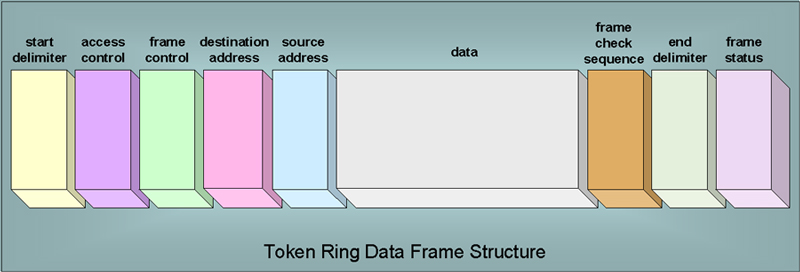
Token Ring Networks
Token Rings. Token Rings networks were initially developed by IBM in the 1980s. It was developed to overcome some of the problems in contention based transmission protocols like Ethernet. Thus, in general the efficiency or effective use of available band width is typically much better in Token Ring networks relative to Ethernet. But unfortunately, the costs are sufficiently larger to cause most organizations to end up using Ethernet of some sort. In fact, primarily due to these cost issues Token Rings have become almost non-existent. But it seems it is still worthwhile to spend some time discussing them since, for example, they
Token Rings are usually used to integrate smaller devices along with IBM mainframe systems and provide Internet access. The specifications for the Token Ring are defined in IEEE 802.5. A Token Ring uses a logical ring topology though not necessarily a physical ring and is usually referred to as a star wired ring. The physical configuration is a star with some sort of central hub or MSAU - Multistation Access Unit. Inside the MSAU the wiring forms a circular data path, creating a logical ring. A signal called a token is passed around this ring and each device cannot transmit until the token gets to it. The token can travel in either direction, but in only one direction at a time. The token is used both to initiate transmissions and make sure they get to their destination. This way there are never any conflicts on the network. This is how they make considerably more effective use of the available bandwidth versus Ethernets. Usually shielded twisted pair or coax are used for cabling. They are usually more reliable and efficient than Ethernets. If they get overloaded their performance degrades more slowly than Ethernets. They also use an active topology in which devices regenerate the signal to help prevent degradation. Older versions were 4 Mbps. Newer implementations operate at 16 Mbps. I've heard rumors that someone is developing something much faster, but have yet to see it in the marketplace. Token Rings are a baseband technology making use of digital signaling. In a Token Ring network the first computer that comes online becomes the "hall monitor". This device then keeps track of how many times each frame circles the ring. It also has the responsibility of ensuring that only one token is out on the network at one time. The monitor computer also periodically sends out a beacon signal. Each computer on the network looks for the beacon and whether it receives the signal from its (NAUN) - nearest upstream neighbor. If it doesn't then it notifies the monitoring computer of its address, the address of its NAUN and that it failed to receive the beacon properly. Sometimes this results in an automatic reconfiguration which restores communications. Hardware Components. Token rings require specialized hardware components and one of the main reasons it is implemented less than Ethernets is because these components are more expensive. The hub at the center of the star is called an MSAU - Multistation Access Unit. Multiple MSAUs can be joined together as long a the out port of one is connected to the in port of the next preserving the integrity of the ring. The data must travel in a continuous circle. Token Ring network cards come in different speeds, 4Mbps and 16Mbps. You can use 16Mbps cards on 4Mbps networks, but they still run at the slower speed. You can't use 4 Mbps cards on 16 Mbps networks. Token Ring networks make use of IBM type 1, 2 or 3 cable. They also make use of a special connector called a type A connector. Unfortunately, these are not compatible with Ethernet cables or connectors. The following table gives a summary of IBM cable types. IBM uses the word type rather than category to classify their cabling. |
| IBM Cable Type | Description |
| Type 1 | STP, two pairs of wires with outer shield |
| Type 2 | STP, two pairs of wires for data and four pairs of wire for voice |
| Type 3 | UTP, four pairs of wires and uses RJ-45 or RJ-11 connectors |
| Type 5 | Fiber optic cable |
| Type 6 | STP used as data patch cable |
| Type 9 | Plenum grade STP cable |
| MIC - Media Interface
Connectors are used to connect type 1 and type 2 cable.
Media filters are used to connect a Token Ring NIC to a modular jack and
to reduce noise on the line. Repeaters can also be used to
regenerate the digital signal and extend the length of the network. Token Ring is highly reliable and eliminates the collisions that Ethernet networks experience. MSAUs can detect the failure of network cards and disconnect it from the ring so that data can still travel around the network. Thus the network is not brought down by a single device unless it's the MSAU. Token Rings can also be used to create interoperability between PC and mainframe networks. Frame Structure. Token Ring networks make use of three different types of frames.
The Token Ring frame structure is a bit more complex than their more typical Ethernet frames. The following image represents the structure of a Token Ring data frame. |

The start delimiter serves the same basic purpose as
the preamble in an Ethernet frame. The following outline gives a
brief description of each of the data frame fields.
Rules of Engagement. The specifications for Token Rings place some constraints on its implementation. The following bulleted list surveys them.
|